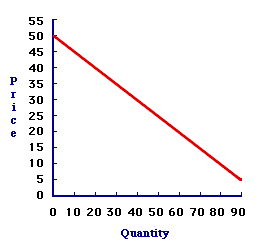Demand:
-Quantity Demanded
-Demand Schedules
-Shifts versus Moving Along The Curve
Quantity Demanded is not the same thing as 'Demand'
Supply:
-Quantity Supplied
-Supply Schedules
-Shifts and Movements
Friday: How do you make a deal? How do suppliers and 'demanders' meet in the middle?
DEMAND:
The Quantity Demanded is the quantity a buyer is willing to purchase given the price, (P), with all other things held constant (ceteris paribus).
We are basically measuring two variables against each other: Price and Quantity Demanded. In order to do this, we need to artificially control all of the other possible factors so that they do not affect the graph, etc.
If the price is $1, how many condoms do you want to buy?
If the price is 80 cents, how many condoms do you want to buy?
Here is a demand schedule for Condoms:
Price Quantity Bought
1.00 --> 1
0.80 --> 3
0.60 --> 5
0.40 --> 8
0.20 --> 11
Why do we buy more when the price is lower? BECAUSE THE OPPORTUNITY COST HAS FALLEN! Eg- buying one condom is now the equivalent to 1/16th of a can of coke instead of a whole can of coke.
Price affects our willingness to buy.
There is an inverse relationship between price and the quantity demanded. As price falls, the quantity demanded rises (I work at co-op. I have witnessed this).
HERE ARE THE OTHER FACTORS WHICH CAN AFFECT Quantity Demanded!
-Income
-Tastes
-Advertising
-Price of complimentary goods
-Price of substitute goods
-Population
-Wealth
-Expectations
See Gateman's notes to fill in the details tonight!
Okay. The price of beer drops. What happens to your willingness to buy condoms? It's subjective; different people behave differently. However, for the sake of understanding, you buy more condoms and this is why.
If the price of beer drops, beers opportunity cost is lower, so you will buy more beer. If you buy more beer, you will need to buy more condoms because they are COMPLIMENTARY.
Substitute goods work the opposite way. If two goods are in competition with each other for an example, a drop in Price in one causes you to buy less of the other.
For an example, if the price of coke drops, you will buy less Pepsi.
Wealth is accumulated income, which is storehoused (it's a bit different from income). Generally, the more wealth you have accumulated, the more you spend for both practical and cultural reasons.
Expectations are difficult to prognosticate. The effect of expectations is different for different people. EG: housing market predictions creat expectations.
DEMAND CURVE:
relation between Price, and the Quantity the consumer is willing to purchase, all things held constant (ceteris paribus).
Qd = f (P/I,T,A,Pr, Pop, W, Exp)
Usually, constant variables (the ceteris paribus) are overlined, but he doesn't know how to do this in word processor.
Demand function:
Y = f(x)
Qd = f(P) : This is the math
Inverse Demand Function:
P = g(Qd) : This is the graph
The price is graphed on the Y axis
The Qd is graphed on the X axis

WE DON"T DO QUADRATICS> YAYA!

No comments:
Post a Comment